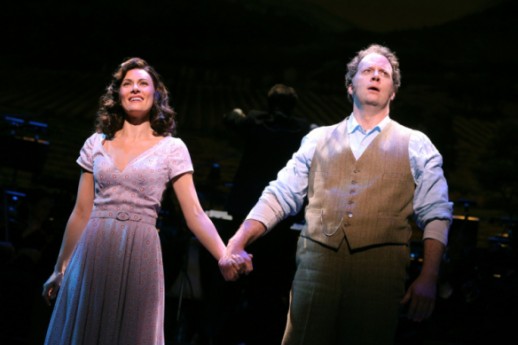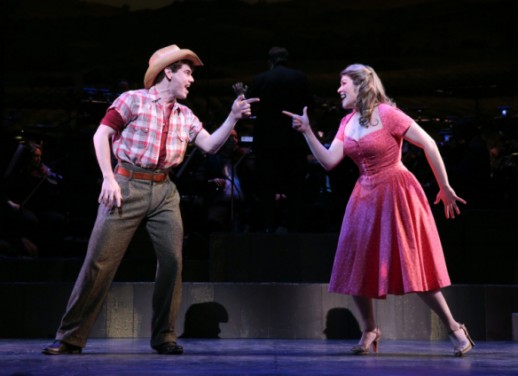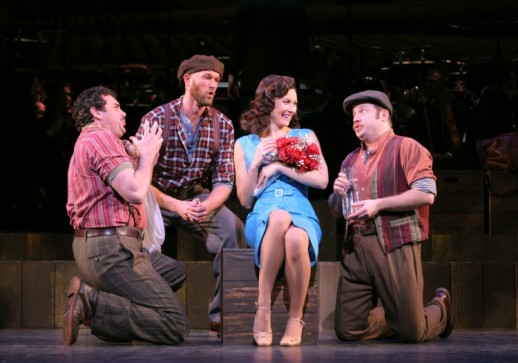

In Frank Loesser’s 1956 musical The Most Happy Fella, Tony Esposito, an Italian grape farmer who admits he isn’t so bright and that his English is “goddamn poor,” is smitten by a San Francisco waitress—Laura Benanti, her soprano ravishing in spite of a lingering flu—and, after offering her his tie clip, asks for her hand in marriage. Tony, played with warmth by Shuler Hensley, writes her a letter addressed to “Rosabella” and summons the good citizens of Napa Valley to prepare an opulent wedding.
Unfortunately Rosabella’s welcome is less gracefully executed than Tony hoped. Rosabella arrives to meet not Tony, but rather a strapping young man named Joe—Cheyenne Jackson, in superb voice. Meanwhile, Tony suffers an unfortunate fall and finds himself temporarily wheelchair-bound. Hardly the first impression he hoped to make on Rosabella. Yet he pleads for her to marry him in case he passes away from his injury. She hesitates but they wed nonetheless. Joe, who now has to stay at the ranch instead of exploring the world as planned, tries to comfort Rosabella and they make love in a moment of weakness.
The Most Happy Fella, directed here by Casey Nicholaw (Aladdin and Book of Mormon), is frequently described in musical theatre circles as a masterpiece for its glorious score. Who knew the composer of the brassy Guys and Dolls could achieve such a seamless fusion of styles, from comedic bel canto to comedic “can belto?”
Indeed the audience has little time to get used to a single musical style. While Benanti and Hensley have beautiful arias and duets (“Warm All Over” and “My Heart Is So Full of You”) and a troupe of opera singers perform Rossinian trios (“Abbodanza” and “Benvenuta”), Fella also tips its hat to tin pan alley in numbers like “Big D,” which stops the show thanks to the energetic Heidi Blickenstaff and Jay Armstrong Johnson. Johnson is also superb leading the male quartet, “Standing on the Corner.” I would describe the vocal ensembles and choruses as something akin to blissful perfection, with a cast of young singers drawn from the worlds of opera and musical theatre.
The Encores! series allows audiences to hear forgotten musicals presented in concert version with original orchestrations and a starry cast of Broadway performers who put it all together in less than two weeks. What used to be a sparse affair—actors in black garb ‘parking and barking’ with their scripts in hand—has evolved into a nearly fully staged production. Indeed, not one of the nearly 40 actors in The Most Happy Fella used a script and all appeared to be enjoying themselves immensely.
It may very well be that The Most Happy Fella is more suited to the Encores! treatment than almost any other musical. The Encores! series allows for luxuries that would be completely unaffordable on Schubert Alley, including an excellent 40-piece orchestra led by Rob Berman, and a large, experienced ensemble.
Rosabella is a challenging role in the sense that she must sparkle and captivate—turning grown men like Tony into girl chasing schoolboys—but also pensive and often melancholy. She is kindhearted and polite—her etiquette lesson to Tony, the duet “Happy to Make Your Acquaintance,” is a highlight—but she is running out of patience with an absence of love and opportunity. She becomes a devoted wife to Tony, but only after making an impulsive decision at a moment of vulnerability. Benanti, a Tony Award winner for Gypsy, with versatility unmatched on today’s Broadway stages, offers a radiant performance that showcases her rich legit soprano.
Tony is also a difficult role to cast, and Encores! likely chose to mount Fella with the gifted Hensley in mind. With a rich baritone and comfortable stage presence—though he sounded strained in the higher vocal passages of the role, perhaps due to fatigue, as he finished performances in Broadway’s Waiting for Godot and No Man’s Land double bill just days before Fella opened—his performance is memorable for its honesty and ardour.

The ensemble—dressed in colourful costumes by Gregg Barnes—bursts with energy and supports, rather than distracts from, the storytelling. I noticed a number of the ensemble members had also appeared in the stunning New York Philharmonic concert version of Carousel last year, in which Hensley played the villainous Jigger.
I emerged from City Center grinning from ear to ear. This was my first evening at Encores! and it was a highlight of my years as a theatregoer. Regrettably, The Most Happy Fella ran for a mere five days and will now occupy a special place in the hearts of all who were able to experience this moving musical performed with such verve and musicality. I imagine the cast and orchestra will similarly cherish the experience for many years to come.
Photos: Joan Marcus


























Comments